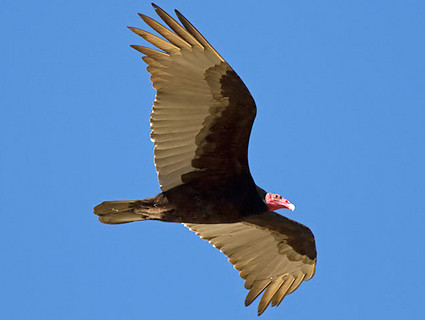Have you ever looked up on a clear, sunny day and spotted dark shapes circling effortlessly in the sky? If you live in an area frequented by wild turkeys, chances are those specks are Turkey Vultures. Observing these birds soaring at great heights naturally leads to the question: just how high can vultures, and other birds, actually fly? Let’s delve into the fascinating world of avian altitude and uncover the aerial limits of these scavenging masters.
Unveiling Vulture Flight Altitudes
Driven by curiosity about the seemingly limitless heights these birds reach, research reveals some compelling data about vulture flight habits. According to a Stanford University essay, Turkey Vultures are known to ascend to altitudes exceeding 10,000 feet. This impressive height serves a strategic purpose: from such a vantage point, vultures can efficiently survey vast landscapes, maximizing their search for food. Furthermore, observing the behavior of distant vultures at these heights can provide valuable clues about potential feeding opportunities.
 Turkey Vulture soaring high above, wings in a dihedral shape
Turkey Vulture soaring high above, wings in a dihedral shape
While 10,000 feet is a significant altitude, it’s important to note that most birds typically fly much lower. The same Stanford essay highlights that the majority of birds remain below 500 feet under normal circumstances. Flying at higher altitudes demands more energy, and lower altitudes often suffice for their daily activities. Moreover, higher altitudes can expose birds to stronger winds and increased predation risks from keen-eyed hawks.
However, migration is a different story. During long journeys, birds frequently ascend to considerable heights. Caribbean migrating birds, for instance, are commonly observed around 10,000 feet, with some venturing as high as 20,000 feet or as low as half that altitude. Long-distance migrants typically start their journey around 5,000 feet and progressively climb to approximately 20,000 feet. This altitude adjustment is similar to jet aircraft, where optimal cruising altitude increases as fuel is consumed and weight decreases. It’s hypothesized that higher altitudes during migration might help birds avoid dehydration by escaping the warmer air closer to the ground.
Record-Breaking Bird Altitudes
For truly astonishing avian altitudes, consider the remarkable case of Whooper Swans. A flock of these swans was once detected on radar arriving over Northern Ireland during migration. An airline pilot visually confirmed their identity at an incredible 29,000 feet. This record-breaking altitude underscores the exceptional physiological adaptations of birds. Their respiratory systems are far more efficient than those of mammals, enabling them to extract a greater fraction of oxygen from the thinner air at high altitudes, making flight possible even where bats cannot venture.
Turkey Vulture Flight Characteristics
Turkey Vultures are not only high-flyers but also masters of efficient flight. They are easily recognized by their dihedral wing shape, resembling a shallow “V,” and their characteristic “wobbly” or rocking motion during flight. This dihedral shape aids in stability and soaring. These birds are incredibly graceful in the air, capable of soaring for hours without flapping their wings. Flapping is reserved primarily for take-offs and landings and appears somewhat labored compared to their effortless soaring.
 Turkey Vulture soaring high above, wings in a dihedral shape
Turkey Vulture soaring high above, wings in a dihedral shape
Vultures typically commence flying a few hours after sunrise, waiting for the morning air to warm up and create thermals, rising columns of warm air. They expertly utilize these thermals to gain altitude. Vultures circle within thermals, ascending effortlessly, and then glide across the sky at speeds reaching up to 60 miles per hour, gradually losing altitude as they travel. To regain height, they locate another thermal and repeat the cycle of circling, rising, and gliding. This thermal-hopping technique allows Turkey Vultures to cover extensive distances with minimal wing flapping, conserving energy.
It’s a common misconception that circling vultures always indicate a dead animal below. While they are scavengers, circling vultures can be engaged in various activities: gaining altitude for long-distance travel, actively searching for food, or even simply engaging in playful aerial maneuvers.
These adaptable soarers utilize two primary flight strategies: low-altitude glides for sniffing out carrion close to the ground, and thermal soaring to reach higher vantage points for broader searches. They may soar individually or in small groups, often congregating in larger numbers at roosting sites. Their exceptional sense of smell, combined with their soaring prowess, makes them highly effective scavengers, playing a vital role in cleaning up the environment. You might also spot them on the ground in small groups, especially around roadkill or near dumpsters, where food sources are readily available.
Resources:
